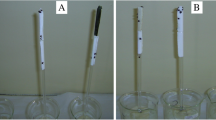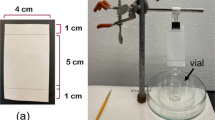Abstract
Motivated by observations that the canine anti-inflammatory cream DogsBestFriend™ (DBF) appeared to deter flies, mosquitoes, and ticks from treated animals, repellent efficacy bioassays using four species of ticks were conducted with three extracts of Nigella sativa L. (Ranunculaceae), a constituent of DBF. The DBF cream was tested against nymphs of lone star tick, Amblyomma americanum (L.). In vertical filter paper assays, the three extracts applied at 0.413 mg extract/cm2 filter paper repelled 96.7–100 % of brown dog tick, Rhipicephalus sanguineus (Latreille) nymphs, whereas, at the same rate, only one extract repelled >90 % A. americanum nymphs. Adult (mixed sexes) American dog ticks, Dermacentor variabilis (Say), required a higher concentration to be repelled effectively; two extracts, applied at 0.827 mg extract/cm2 filter paper, repelled ≥90 % of the D. variabilis. In contrast, all extracts applied at much lower concentration (0.206 mg extract/cm2 filter paper) repelled 100 % adult blacklegged ticks, Ixodes scapularis Say (only females tested). Of the two more repellent extracts, one lost most of its activity against A. americanum nymphs in <4 h when applied at 0.827 mg extract/cm2 filter paper, whereas the other repelled 66.7 % of the nymphs at 192 h after application. At 0.206 mg extract/cm2 filter paper, one extract was as repellent as deet against A. americanum nymphs. In a vertical bioassay in which nylon organdy was substituted for filter paper, DBF, at the rates of 1.67 and 0.835 mg cream/cm2, repelled 76.7 and 30.0 % A. americanum nymphs, respectively. These findings indicate that when applied appropriately DBF should afford some protection to canines against tick bites.



Similar content being viewed by others
References
Abu-Al-Basal MA (2009) In vitro and In vivo anti-microbial effects of Nigella sativa Linn. seed extracts against clinical isolates from skin wound infections. Am J Appl Sci 6:1440–1447
Adrion ER, Aucott J, Lemke KW, Weiner JP (2015) Health care costs, utilization and patterns of care following Lyme disease. PLoS ONE. doi:10.1371/journal.pone.0116767
Ali BH, Blunden G (2003) Pharmacological and toxicological properties of Nigella sativa. Phytother Res 17:299–305
Al-Mutheffer EA (2010) The effect of local application black seed (Nigella sativa) oil on wound healing in rabbits Al-Anbar. J Vet Sci 3:91–97
Amin B, Hosseinzadeh H (2016) Black cumin (Nigella sativa) and its active constituent, thymoquinone: an overview on the analgesic and anti-inflammatory effects. Planta Med 82:8–16
Bissinger BW, Roe RM (2010) Tick repellents: past, present, and future. Pestic Biochem Physiol 96:63–79
Bissinger BW, Apperson CS, Sonenshine DE, Watson DW, Roe MR (2009) Efficacy of the new repellent BioUD® against three species of ixodid ticks. Exp Appl Acarol 48:239–250
Bulugahapitiya VP, Arachchige PTK (2007) Mosquito repellent compounds from the seeds of Nigella sativa L. (Black cumin). In: Proceedings of the Fourth Academic Sessions, University of Ruhuna, Sri Lanka, pp 151–158
Carroll JF, Solberg VB, Klun JA, Kramer M, Debboun M (2004) Comparative activity of deet and AI3-37220 repellents against the ticks Ixodes scapularis and Amblyomma americanum (Acari: Ixodidae) in laboratory bioassays. J Med Entomol 41:249–254
Carroll JF, Paluch G, Coats J, Kramer M (2010) Elemol and amyris oil repel the ticks Ixodes scapularis and Amblyomma americanum (Acari: Ixodidae) in laboratory bioassays. Exp Appl Acarol 51:383–392
Carroll JF, Tabanca N, Kramer M, Elejalde NM, Wedge DE, Bernier UR, Coy M, Becnel JJ, Demirci B, Can Başer KH, Zhang J, Zhang S (2011) Essential oils of Cupressus funebris, Juniperus communis, and J. chinensis (Cupressaceae) as repellents against ticks (Acari: Ixodidae) and mosquitoes (Diptera: Culicidae) and as toxicants against mosquitoes. J Vector Ecol 36:258–268
CDC (2002) Lyme disease. Department of Health and Human Services, Centers for Disease Control and Prevention, Ft. Collins
CDC (2013) CDC provides estimate of Americans diagnosed with Lyme disease each year. http://www.cdc.gov/media/releases/2013/p0819-lyme-disease.html. Accessed 20 June 2014
Childs JE, Paddock CD (2003) The ascendancy of Amblyomma americanum as a vector of pathogens affecting humans in the United States. Annu Rev Entomol 48:307–337
Debboun M, Frances SP, Strickman D (2007) Insect repellents: principles, methods, and uses. CRC Press, Boca Raton
Ghosheh OA, Houdi AA, Crooks PA (1999) High performance liquid chromatographic analysis of the pharmacologically active quinones and related compounds in the oil of the black seed (Nigella sativa L.). J Pharm Biomed Anal 19:757–762
Goddard J, Varela-Stokes AS (2009) Role of lone star ticks, Amblyomma americanum (L.), in human and animal diseases. Vet Parasitol 160:1–12
Hannan A, Saleem S, Chaudhary S, Barkaat M, Arshad M (2008) Antibacterial activity of Nigella sativa against clinical isolates of methicillin resistant Staphylococcus aureus. J Ayub Med Coll Abbottabad 20:72–74
Hothorn T, Bretz F, Westfall P (2008) Simultaneous inference in general parametric models. Biom J 50:346–363
Mahmoudvand H, Sepahvand A, Jahanbakhsh S, Ezatpour B, Ayatollahi Mousavi SA (2014) Evaluation of antifungal activities of the essential oil and various extracts of Nigella sativa and its main component, thymoquinone against pathogenic dermatophyte strains. J Mycol Med 24:e155–e161
Majdalawieh AF, Fayyad MW (2015) Immunomodulatory and anti-inflammatory action of Nigella sativa and thymoquinone: A comprehensive review. Int Immunopharmacol 28:295–304
McAllister JC, Adams MF (2010) Mode of action for natural products isolated from essential oils of two trees is different from available mosquito adulticides. J Med Entomol 47:1123–1126
Mixson TR, Campbell SR, Gill JS, Ginsberg HS, Reichard MV, Schulze TL, Dasch GA (2006) Prevalence of Ehrlichia, Borrelia, and rickettsial agents in Amblyomma americanum (Acari: Ixodidae) collected from nine states. J Med Entomol 43:1261–1268
Owen T (1805) Geoponika: agricultural pursuits. www.ancientlibrary.com/geoponica/index.html
Pacioretty LM, Babish JG, Debenedetto J (2013) Compositions from Nigella sativa. US Patent 8,535,740
Pages F, Dautel H, Duvallet G, Kahl O, de Gentile L, Boulanger N (2014) Tick repellents for human use: prevention of tick bites and tick-borne diseases. Vector-Borne Zoonotic Dis 14:1–9
Piesman J, Eisen L (2008) Prevention of tick-borne diseases. Annu Rev Entomol 53:323–343
Schreck CE, Mount GA, Carlson DA (1982) Wear and wash persistence of permethrin used as a clothing treatment for personal protection against the lone star tick (Acari: Ixodidae). J Med Entomol 19:143–146
Schreck CE, Fish D, McGovern TP (1995) Activity of repellents applied to skin for protection against Amblyomma americanum and Ixodes scapularis ticks (Acari: Ixodidae). J Am Mosq Control Assoc 11:136–140
Sonenshine DE (1993) Biology of ticks. Oxford University Press, New York
Spielman A, Wilson ML, Levine JF, Piesman J (1985) Ecology of Ixodes dammini-borne human babesiosis and Lyme disease. Annu Rev Entomol 30:439–460
Stafford KC III (2007) Tick management handbook. Connecticut Agric Exp Sta Bull No. 1010
R Core Team (2014) R: a language and environment for statistical computing, Vienna, Austria. http://www.R-project.org
Weldon PJ, Carroll JF, Kramer M, Bedoukian RH, Coleman RE, Bernier UR (2011) Anointing chemicals and hematophagous arthropods: responses by ticks and mosquitoes to citrus (Rutaceae) peel exudates and monoterpene components. J Chem Ecol 37:348–359
Yousefi M, Barikbin B, Kamalinejad M, Abolhasani E, Ebadi A, Younespour S, Manouchehrian M, Hejazi S (2013) Comparison of therapeutic effect of topical Nigella with Betamethasone and Eucerin in hand eczema. J Eur Acad Dermatol Venereol 27:1498–1504
Acknowledgments
We thank James McCrary, USDA, ARS, Invasive Insect Biocontrol and Behavior Laboratory, Beltsville Agricultural Research Center, Beltsville, MD, USA, for conducting behavioral bioassays.
Author information
Authors and Affiliations
Corresponding author
Additional information
J. F. Carroll is retired from USDA, ARS, Invasive Insect Biocontrol and Behavior Laboratory, Beltsville Agricultural Research Center, Beltsville, MD, 20705, USA.
Rights and permissions
About this article
Cite this article
Carroll, J.F., Babish, J.G., Pacioretty, L.M. et al. Repellency to ticks (Acari: Ixodidae) of extracts of Nigella sativa (Ranunculaceae) and the anti-inflammatory DogsBestFriend™. Exp Appl Acarol 70, 89–97 (2016). https://doi.org/10.1007/s10493-016-0058-x
Received:
Accepted:
Published:
Issue Date:
DOI: https://doi.org/10.1007/s10493-016-0058-x




